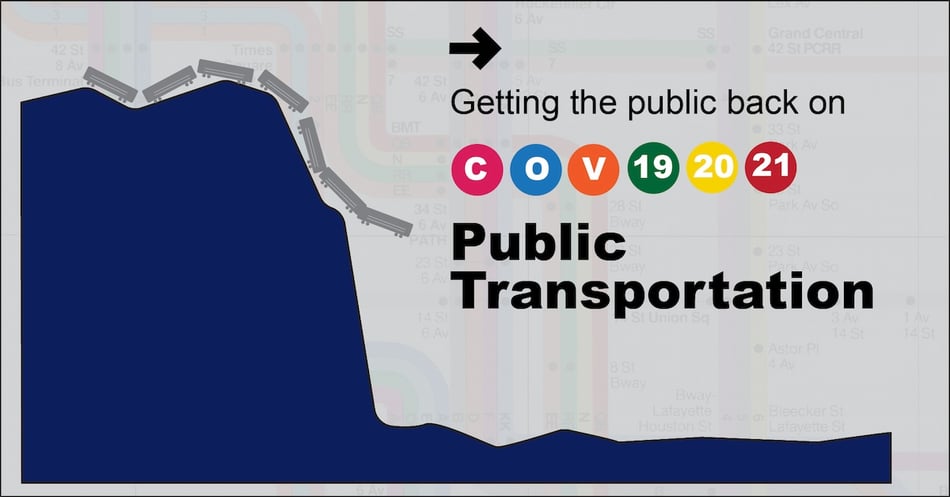Putting the Public Back on Public Transportation

![covid public transport [Recovered]-01](https://blog.eoscu.com/hs-fs/hubfs/Marketing/Blog_Headers/covid%20public%20transport%20%5BRecovered%5D-01.jpg?width=1959&name=covid%20public%20transport%20%5BRecovered%5D-01.jpg) Public transportation was one of the hardest hit sectors during the COVID pandemic. Some cities, such as San Francisco, saw ridership go down as much as 95%, leading to great losses in revenue for these city- and state-funded systems (making those which rely more on fares than on taxes especially vulnerable). There is a projected revenue shortfall of $39.3 billion for nationwide public transit systems through 2023, despite almost the same amount being provided from the federal government through CARES and CRRIAA Acts. Getting the public back onto public transportation is therefore of primary importance to the financial recovery of both the public transportation systems and the regions they serve. A big part of this recovery during the pandemic is getting the public to trust that their health is not in danger when they ride a bus, subway, or train. Just how does a public transportation system get the public back on board?
Public transportation was one of the hardest hit sectors during the COVID pandemic. Some cities, such as San Francisco, saw ridership go down as much as 95%, leading to great losses in revenue for these city- and state-funded systems (making those which rely more on fares than on taxes especially vulnerable). There is a projected revenue shortfall of $39.3 billion for nationwide public transit systems through 2023, despite almost the same amount being provided from the federal government through CARES and CRRIAA Acts. Getting the public back onto public transportation is therefore of primary importance to the financial recovery of both the public transportation systems and the regions they serve. A big part of this recovery during the pandemic is getting the public to trust that their health is not in danger when they ride a bus, subway, or train. Just how does a public transportation system get the public back on board?
A study conducted at the end of 2020 revealed some interesting trends that show not every city is dealing with the same ridership declines. Some cities had huge drop-offs, while others did not. This study concluded that "greater decreases in transit are associated with higher percentage of people with non-physical occupations." Let's take a closer look at these findings.
Cities such as San Francisco, San Diego, Denver, and Grand Rapids saw huge drop-offs in public transportation ridership. Meanwhile, many cities in the south, along with St. Louis and Philadelphia saw less dramatic drop-offs. Hugely impacted cities like New York, were effected more in some systems (rail) than others (bus). Why did some cities maintain higher ridership numbers? It all came down to two issues.
#1: Physical Occupations | Not everyone can work from home.
Occupations in construction, healthcare, retail, sanitation and many other essential jobs must be done in-person. Cities that had a high percentage of workers in physical occupations did not see the same drop-offs in public transportation because those workers had to keep going in to work in order to have a salary, not to mention in order to provide essential services to keep society functioning. Many of these occupations are also lower-paying jobs, which brings us to our next issue.
#2: Transportation Options | Not everyone has a car.
Workers in lower-paying positions often rely on public transportation as their only means of transportation. Cities with a high percentage of workers who both have to do their jobs in person and don't have access to a private vehicle saw less dramatic public transportation drop-offs. This can sometimes vary by transit system: Some cities saw huge drop-offs in rail, but maintained high ridership in buses. Why? Train riders tended to have non-physical occupations, while bus-riders did not. This graph about New York City specifically, shows these differences effectively.
At the root of getting more of the public back aboard public transportation is trust. The public needs to trust that transit systems are investing in keeping them safe before they choose to return to public transportation. Transit systems are getting the word out that the CDC has stated that riding public transportation is safe if masks are worn, if there is adequate ventilation, and crowding is minimized. All transit companies are enhancing cleaning protocols and making sure the public knows it. In some cases, cities have increased the number of routes to decrease crowding.
Some cities are even installing new materials that are visible evidence of investment in the health of riders. While the risks of COVID transmission from surfaces is low in certain circumstances, the risk is magnified in areas where thousands upon thousands of people pass through, such as on public transportation. (Or where the people are vulnerable to any pathogen, such as a hospital.) Cleaning these surfaces thoroughly once per day means they are clean for a few minutes, but they become contaminated as soon as they are put into public use. This is why handwashing is still considered an essential part of limiting the transmission of COVID and other diseases. Another weapon against this daily recontamination is a biocidal surface that kills pathogens throughout the day, such as copper and copper-infused materials.
Ultimately, those that have other transportation options will return to public transit when they no longer feel the risk outweighs the benefits. Vaccinations will be a huge help to getting people to feel comfortable riding again, but they will return with a heightened sensitivity to safety, looking for routes and systems that provide the added measures to protect them from illness. When the public has a choice about how they get around, they will need to feel confident before they get back aboard public transportation.
![EOScu Logo - Dark - Outlined [07182023]-01](https://blog.eoscu.com/hubfs/Eoscu_June2024/Images/EOScu%20Logo%20-%20Dark%20-%20Outlined%20%5B07182023%5D-01.svg)




